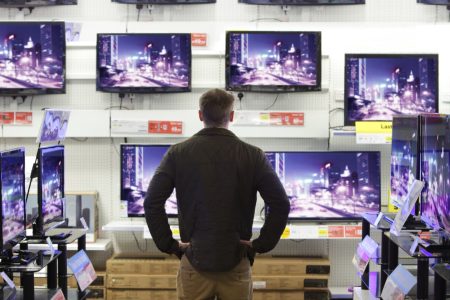It’s the nature of prices to go up over time, even in low-inflation environments. Historically, the target for the U.S. Federal Reserve has been 2% annual inflation.
So when worldwide events like the Covid-19 pandemic push inflation well above that 2% target, it can be a real shock to consumers. Since hitting 9% in June 2022, it’s been a slow crawl to get the pace of inflation down to the Fed’s preferred target.
And while inflation has indeed pulled back from that 2022 peak — now down to 3%, according to the most recent consumer price index from the U.S. Bureau of Labor Statistics — prices are still about 20% higher than they were pre-pandemic.
There are a handful of retail categories, dominated by consumer electronics, that buck the trend and are actually cheaper now than they were before the pandemic, based on a CNBC review of CPI categories in June 2024 compared with June 2019.
That includes telephone hardware; televisions; audio equipment; computers; certain cookware; and toys, game and hobby items.
Same price, better value
Even when annual inflation was at its peak, prices for consumer electronics consistently showed signs of deflation. Some of that has to do with nuances with the calculation of the CPI itself.
Prices for smartphones, for example, which are a large component of the telephone hardware category, get special adjustments at the Bureau of Labor Statistics to account for rapid improvements in technology.
The CPI routinely shows that smartphone prices are falling, but it’s actually reflecting that consumers are getting better, more sophisticated products for the same price.
Such hedonic adjustments — the term BLS uses to describe it’s adjustments for changes in item quality — span the whole consumer price index and include categories from men’s underwear to home computers to refrigerators. They’re meant to reflect the change in value that the consumer is receiving for what they’re paying.
Why televisions continue to be cheap
But hedonic adjustments can’t account for everything when the CPI is registering drops in prices. Televisions are a good example: Prices keep falling, but in some cases, manufacturers have to slash prices to stay competitive and get consumers’ attention.
“Purely from a manufacturing standpoint, in general with new technology and consumer electronics, there’s a learning curve that naturally evolves, which lowers the cost of a product without compromising the quality,” Andrew Csicsila, head of the Americas for consumer products at AlixPartners, told CNBC ahead of Black Friday last year.
That’s happened aggressively with smart TVs, to the point that the technology has become pretty universal and making it difficult to compete on product features. But Csicsila has also cited other revenue streams for manufacturers that allow them to sell units barely above cost and flood the ultra-competitive marketplace with low-price products.
“The reason they’re trying to do this is really to gain data,” Csicsila said. “If you look…

